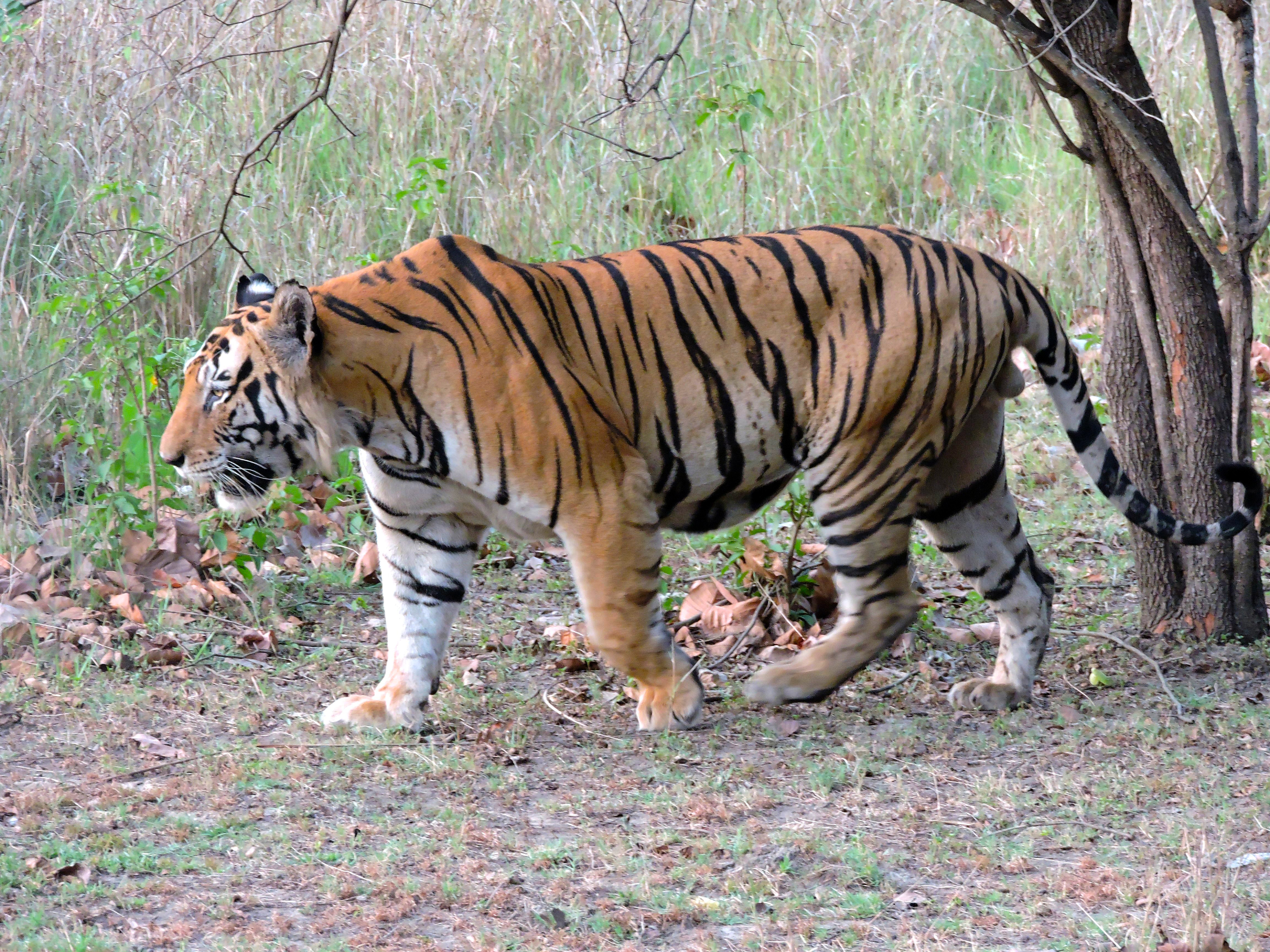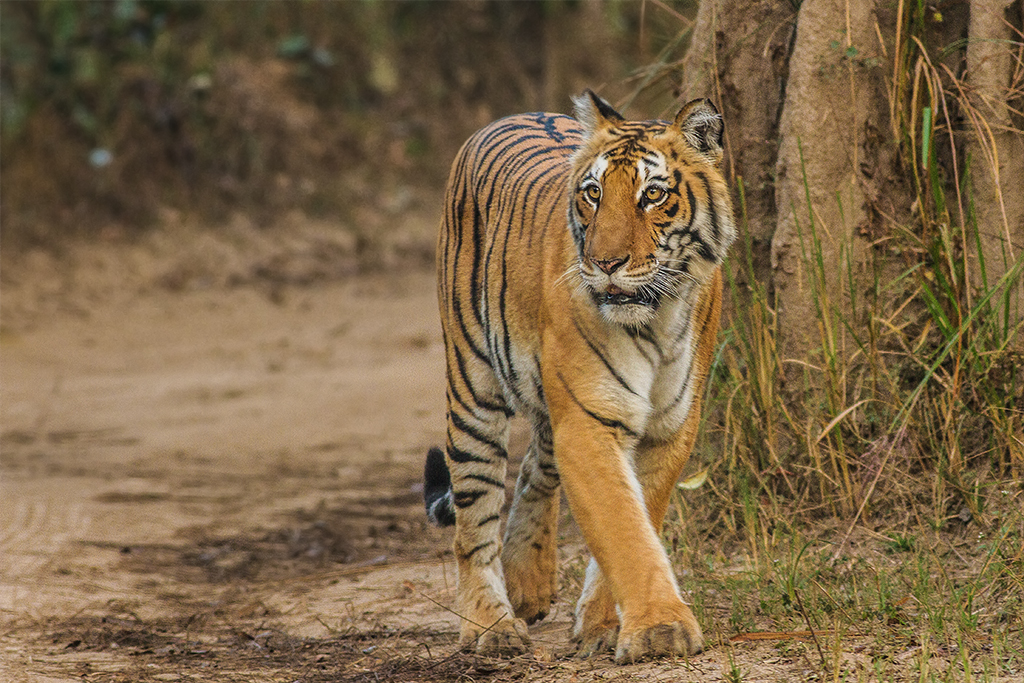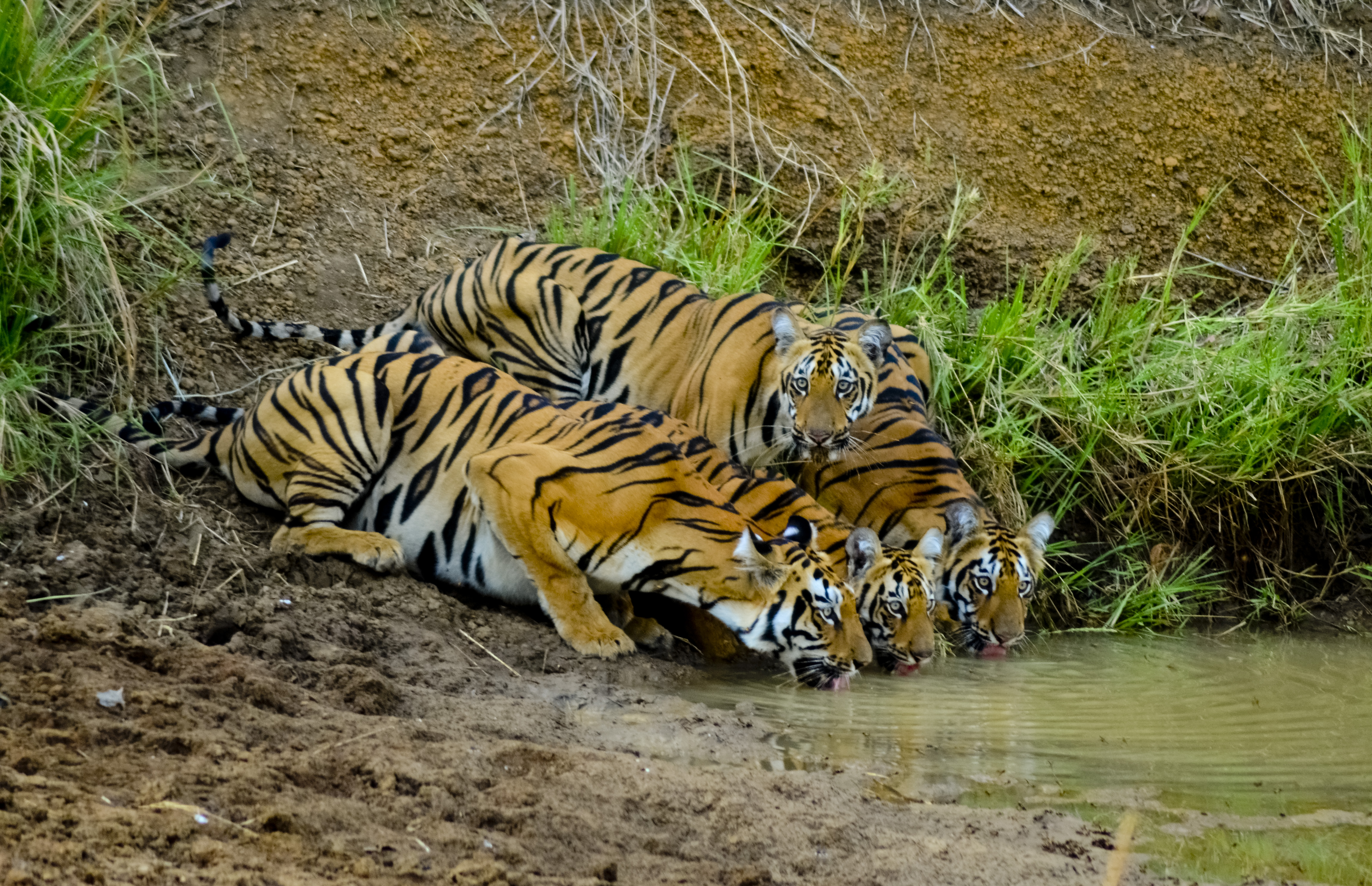 |
Seemaleena, CC BY-SA 4.0, via Wikimedia Commons Adult Male, Bengal Tiger |
These majestic animals roam freely in some of the most breathtaking forest reserves, spanning grasslands, dense jungles, and riverine landscapes.
The country’s top tiger forests are not only strongholds for tiger populations but also preserve rich biodiversity, tribal culture, and eco-tourism opportunities.
This essay explores the most famous tiger reserves in India: their natural beauty, conservation success stories, incredible flora and fauna, and practical travel information including how to reach them, best visiting seasons, and accommodation options.
1. Bandhavgarh Tiger Reserve, Madhya Pradesh
Nature and Landscape
 |
| Prabukumar84, CC BY-SA 4.0, via Wikimedia Commons Bandhavgarh National Park |
Tiger Conservation Efforts
Bandhavgarh is known for having one of the highest densities of Bengal tigers in the world. Once home to the famous white tigers of Rewa, the park now boasts dozens of camera-trapped tigers. Protection strategies include 24/7 patrolling, forest surveillance teams, radio collars for tracking, and partnerships with local communities to reduce human-wildlife conflict.
Flora and Fauna
Apart from tigers, Bandhavgarh shelters leopards, sloth bears, Indian gaurs, barking deer, and wild boars. The park is also rich in avifauna with over 250 bird species including vultures, flycatchers, owls, and peacocks. The flora includes sal, dhak, tendu, and various medicinal plants.
Best Time to Visit
The park remains open from October to June. Summer (April–June) provides the best chance to spot tigers near water bodies. Winters (November–February) are ideal for birdwatching and jungle treks.
How to Reach
-
By Air: The nearest airports are Jabalpur (160 km) and Khajuraho (250 km).
-
By Rail: Umaria is the closest railway station (32 km).
-
By Road: Connected to cities like Jabalpur, Katni, and Satna by road.
Accommodation
You can find a wide range of stays—from budget lodges and jungle camps to luxury eco-resorts near Tala Gate. Many resorts offer in-house naturalists, guided safaris, and local village visits.
2. Ranthambore Tiger Reserve, Rajasthan
Nature and Landscape
 |
| Harsh.kabra.98, CC BY-SA 4.0, via Wikimedia Commons The picture was shot on zone 3 of Ranthambore tiger reserve. |
The park’s rugged terrain features rocky ridges, lakes, dry deciduous forest, and the majestic Ranthambore Fort towering over the forest canopy.
The scenic Padam Talao lake is especially famous for tiger sightings.
Tiger Conservation Efforts
Ranthambore has seen impressive tiger recovery thanks to strict protection measures. It now hosts around 50+ tigers including the world-famous tigress Machli, whose lineage still roams here. Anti-poaching units, drone monitoring, and controlled tourism have helped stabilize the population.
If any tourists need any help, here is the official website of the Government of India to guide the domestic and foreign tourists: India Tourism Development Corporation (ITDC)
Flora and Fauna
The forest is dry and deciduous, dominated by dhok trees. Wildlife includes leopards, striped hyenas, marsh crocodiles, chinkaras, and a wide variety of birds like serpent eagles, vultures, and treepies.
Best Time to Visit
The reserve is open from October to June, with peak tiger sightings during the dry summer months. Safari slots fill quickly during holidays, so booking in advance is advised.
How to Reach
-
By Air: Jaipur Airport (180 km) is the nearest major airport.
-
By Rail: Sawai Madhopur station is just 11 km from the park.
-
By Road: Well-connected to Delhi, Jaipur, and Kota.
Accommodation
Ranthambore offers everything from budget guesthouses and government rest houses to luxury tents and heritage hotels. Many resorts incorporate Rajasthani art and provide wildlife documentary screenings in the evenings.
3. Kanha Tiger Reserve, Madhya Pradesh
Nature and Landscape
 |
| Suhrud92, CC BY-SA 4.0, via Wikimedia Commons Most Beautiful Tigress of Kanha |
It inspired Rudyard Kipling’s “The Jungle Book”. The central Kisli and Mukki zones offer the best safari routes.
Tiger Conservation Efforts
Kanha is a flagship reserve under Project Tiger. It was the first reserve to successfully reintroduce the hard ground barasingha (swamp deer), which was once on the brink of extinction. Tiger monitoring, habitat enrichment, and local tribal participation are hallmarks of its conservation strategy.
Flora and Fauna
Apart from tigers, Kanha is home to Indian leopards, dholes (wild dogs), sloth bears, jackals, and barasinghas. The forest has over 200 flowering plant species, sal trees, bamboo, and medicinal herbs. Bird species include hornbills, parakeets, and jungle fowl.
Best Time to Visit
Kanha is open from October to June. The best time for tiger sightings is during summer, but winter months are good for overall wildlife and forest beauty.
How to Reach
-
By Air: Jabalpur (160 km) and Raipur (250 km) are the closest airports.
-
By Rail: Gondia and Jabalpur stations are most convenient.
-
By Road: Roads from Nagpur, Raipur, and Jabalpur offer good connectivity.
Accommodation
You’ll find forest rest houses, jungle lodges, and high-end safari resorts with naturalists. Staying near Kisli or Mukki gate is ideal for early morning safari access.
4. Jim Corbett Tiger Reserve, Uttarakhand
Nature and Landscape
 |
| Soumyajit Nandy, CC BY-SA 3.0, via Wikimedia Commons Tigress walking on the gypsy track in Bijrani zone. |
It has riverine belts, sal forests, grasslands, and hills.
The Ramganga River flows through the park, attracting an abundance of wildlife.
Tiger Conservation Efforts
Jim Corbett is a pioneer of tiger conservation in India. It has over 260 tigers. The forest department runs a well-organized tourist program to limit interference with wildlife, with regulated zones, trained guides, and anti-poaching patrols.
Flora and Fauna
 |
| Rishisharmacse, CC BY-SA 4.0, via Wikimedia Commons A nice morning with asia's most beautiful creature "The Elephants" |
The forest is rich in sal, chir pine, bamboo, and fig trees.
Best Time to Visit
The park is open from November to June, with Dhikala zone being the most popular. Winters offer clear visibility, while summers offer better chances for tiger sightings.
How to Reach
-
By Air: Nearest airport is Pantnagar (80 km).
-
By Rail: Ramnagar station is just 12 km from the entrance.
-
By Road: Easily reachable from Delhi (250 km) and Dehradun.
Accommodation
Options range from forest rest houses inside the park (like Dhikala) to luxury riverside resorts and eco-lodges in Ramnagar. Booking Corbett’s internal rest houses must be done months in advance.
5. Tadoba-Andhari Tiger Reserve, Maharashtra
Nature and Landscape
 |
Ajinkya Vishwekar, CC BY-SA 4.0, via Wikimedia Commons The mother tigress Sonam & her three cubs in the Tadoba Andhaari Tiger Reserve, India |
It’s a mixture of hilly terrains, bamboo thickets, and teak forests.
The Tadoba Lake and Andhari River provide critical water sources for wildlife.
Tiger Conservation Efforts
Tadoba has gained attention for frequent tiger sightings and its successful tiger population growth. The reserve uses camera traps, patrol routes, and village relocation schemes to reduce pressure on the core zone.
Flora and Fauna
Tadoba houses a wide range of mammals like Indian bison (gaur), leopards, sloth bears, civets, and marsh crocodiles. The forest contains teak, mahua, crocodile bark trees, and flame of the forest. Birdwatchers often spot grey-headed fish eagles and paradise flycatchers.
Best Time to Visit
Open from October to June, with April to June being best for tiger photography. Tuesdays are typically closed for tourism activities.
How to Reach
-
By Air: Nagpur Airport is 140 km away.
-
By Rail: Chandrapur railway station is 45 km away.
-
By Road: Good roads connect Tadoba to Nagpur and Chandrapur.
Accommodation
Buffer zones like Moharli and Kolara offer many resorts and homestays. Some campsites offer walking trails, tribal dance evenings, and local food experiences.
6. Kaziranga National Park, Assam
Nature and Landscape
 |
| Kritartha05, CC BY 4.0, via Wikimedia Commons Photo of one horn rhino |
Tiger Conservation Efforts
Though famous for one-horned rhinos, Kaziranga is also a major tiger reserve. It has one of the highest tiger densities in the world. Flood management, habitat zoning, and local eco-development have helped it thrive as a model conservation park.
Flora and Fauna
In addition to tigers, Kaziranga is home to elephants, swamp deer, wild boars, and the endangered wild water buffalo. Bird species include pelicans, storks, hornbills, and fishing eagles. The flora consists of grasslands, aquatic vegetation, and tropical moist forests.
Best Time to Visit
The park is open from November to April. Floods make the park inaccessible during monsoon (June–September).
How to Reach
-
By Air: Jorhat (96 km) and Guwahati (200 km) are the nearest airports.
-
By Rail: Furkating is the nearest station (80 km).
-
By Road: Well-connected to Guwahati and Tezpur by highway.
Accommodation
Forest lodges, heritage resorts, and Assamese-style cottages are available near Kohora and Bagori ranges. Some offer river cruises and cultural tours.
Other Notable Tiger Forests in India
Nagarhole and Bandipur (Karnataka)
These two interconnected parks in the Western Ghats form one of India’s richest tiger landscapes. Known for elephants, wild dogs, and lush forests.
Mudumalai (Tamil Nadu)
Located near the Nilgiris, this forest reserve is part of the same corridor as Bandipur and is rich in tigers, elephants, and over 200 bird species.
Sariska (Rajasthan)
After losing all its tigers in the early 2000s, Sariska has seen successful tiger reintroduction. It's one of the few parks close to Delhi for weekend safaris.
Conclusion: A Journey into India’s Wild Heart
India’s tiger forests are not just wildlife destinations—they are living examples of ecological balance, community engagement, and conservation leadership. From the grasslands of Kaziranga to the rocky escarpments of Ranthambore, these forests invite tourists to witness the tiger’s realm while supporting sustainable travel. Whether you are a photographer, bird lover, or nature enthusiast, the tiger forests of India offer the most thrilling and soul-stirring experiences in the natural world.
Make sure to choose the best season, book in advance, respect park rules, and support eco-conscious lodges. A tiger forest tour in India is more than a safari—it’s a journey into the wild heart of India.
No comments:
Post a Comment